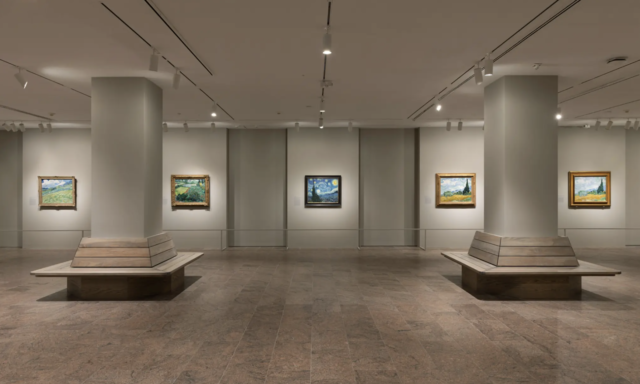
Installation view, “The Making of a Signature Motif: Saint–Rémy, May–September 1889” (photo © 2023 The Metropolitan Museum of Art)
VAN GOGH’S CYPRESSES
Metropolitan Museum of Art, Met Fifth Ave.
Gallery 199
1000 Fifth Ave. at 82nd St.
Through August 27, $30 (NY, NJ, CT residents pay-what-you-wish)
212-535-7710
www.metmuseum.org
In his “Illustrated Letter to Willemien van Gogh (Reminiscence of the Garden at Etten),” Vincent van Gogh writes to his sister, about a painting of the Garden at Etten, “Now here are the colors. The younger of the two women walking is wearing a Scottish shawl with green and orange checks and carrying a red parasol. The old one has a blue-violet shawl, almost black. But a bunch of dahlias, some lemon yellow, others variegated pink and white, explode against this sombre figure. Behind them a few emerald-green cedar or cypress bushes. Behind these cypresses one catches a glimpse of a bed of pale green and red cabbages, surrounded by a border of little white flowers. The sandy path is a raw orange, the foliage of two beds of scarlet geraniums is very green. Finally, in the middle ground is a maidservant dressed in blue who’s arranging plants with a profusion of white, pink, yellow, and vermilion-red flowers. There you are, I know it isn’t perhaps much of a resemblance, but for me it conveys the poetic character and the style of the garden as I feel them.”
The 1888 letter is one of several such dispatches in the revelatory show “Van Gogh’s Cypresses,” a collection of nearly fifty paintings, drawings, and illustrated letters in which van Gogh focused on what Met director Max Hollein calls “the artist’s most enduring, expressive motif. . . . This exhibition offers an unprecedented opportunity to revisit the most famous trees in the history of art.” The centerpiece is MoMA’s The Starry Night; you’ll have to wait in a long line to be able to see it. Most people chat away on the queue until they have their own moment with the painting, snap a few pictures, then walk away. And that’s a shame, because the gallery is filled with small and big gems, familiar masterpieces and sweet surprises, including the glorious Wheat Field with Cypresses right next to The Starry Night, a stunning canvas that so many don’t see as they wander away, checking the photos they just took on their phone.
The show is divided into three chronological sections: “The Roots of His Invention: Arles, February 1888 – May 1889,” “The Making of a Signature Motif: Saint–Rémy, May–September 1889,” and “Branching Out in Style: Saint–Rémy, October 1889 – May 1890.” Drawbridge and The Langlois Bridge offer two renderings of the same bridge; oddly, the pen-and-ink drawing was done after the painting. Still Life of Oranges and Lemons with Blue Gloves, made shortly after his release from the hospital, features cypress needles behind the title objects. There’s a loneliness to Stairs in the Garden of the Asylum, which has no human figures in it, while The Public Garden explores solitude by having three people sharing a bench off to the left and a long path leading to a single person by themselves to the right. Window in the Studio was painted in van Gogh’s hospital studio; the artist used chalk, brush and oil paint, and watercolor on paper to depict a barred window with empty bottles on the sill, loosely drawn paintings on the wall, and a garden outside, all bathed in a yellow-gold tint.
At the asylum, van Gogh told a soldier, “It’s difficult to leave a land before having something to prove that one has felt and loved it.” The master, who died in July 1890 at the age of thirty-seven, proved more than he would ever know with these paintings.
The final two works, A Walk at Twilight and Country Road in Provence by Night, each features a pair of people in the foreground; looking intently at the works, the man next to me wondered which one he would most like to enter.
In order to enter the exhibit, which concludes August 27, you need to first go to the gallery and scan a QR code that will give you the time you can go inside and experience this amazing garden of riches.
[Mark Rifkin is a Brooklyn-born, Manhattan-based writer and editor; you can follow him on Substack here.]